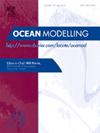Impact of islands on the cross-shelf transport among the Pearl River Estuary, its adjacent coast and inner shelf
IF 2.9
3区 地球科学
Q2 METEOROLOGY & ATMOSPHERIC SCIENCES
引用次数: 0
Abstract
Cross-shelf transport is crucial for material exchange in the estuary-coast-shelf continuum. This study employs the Coupled Ocean-Atmospheric-Wave-Sediment Transport (COAWST) modeling system to quantify the cross-shelf transport and investigate the influence of islands on the cross-shelf transport between the Pearl River Estuary (PRE), the adjacent coast and the inner shelf. A budget-based method is applied to calculate the cross-shelf volume transport across key interfaces: the estuary-coast interface (the exit between Lantau Island and Macau at the PRE mouth) and the coast-inner shelf interface (25 m isobath). The results show that the Lantau-Macau exit serves as a key transport gateway for estuary-coast exchange, with a net offshore transport of 1.97 × 103 m3 s−1 in the dry season and 2.61 × 103 m3 s−1 in the wet season, respectively. The dynamical analysis shows that, at the estuary-coast interface, the islands strengthen the onshore horizontal advection, increasing the net onshore transport by 41.37 % in the dry season, and augment the offshore barotropic gradient, increasing the net offshore transport by 422 % in the wet season. At the coast-inner shelf interface, the cross-shelf transport is onshore at 11.35 × 103 m3 s−1 during the dry season and offshore at 0.74 × 103 m3 s−1 during the wet season. During the dry season, the islands enhance both the onshore and offshore transport through increased bottom pressure torque (BPT) and nonlinear advection, respectively, with the two effects nearly balancing each other. However, in the wet season, the islands strengthen the Joint Effect of Baroclinity And Relief (JEBAR), counteracting the advection and making BPT-driven onshore transport to become dominant, thereby enhancing onshore transport by 63 % at this interface. This study has implications for land-ocean interaction research and effective coastal management.
岛屿对珠江口及其邻近海岸和内陆架间跨陆架运输的影响
跨大陆架运输对河口-海岸-大陆架连续体中的物质交换至关重要。本研究采用海洋-大气-波浪-泥沙耦合输运(COAWST)模式系统,对珠江口(PRE)与邻近海岸和内陆架之间的跨陆架输运进行量化,并研究岛屿对跨陆架输运的影响。采用基于预算的方法计算了关键界面的跨大陆架体积运输:河口-海岸界面(大屿山和澳门之间的出口在PRE口)和海岸-内大陆架界面(25 m等深线)。结果表明:大屿山—澳门出口是河口—海岸交换的重要运输门户,干季和湿季的净离岸运输量分别为1.97 × 103 m3 s−1和2.61 × 103 m3 s−1。动力学分析表明,在河口-海岸界面,岛屿增强了陆上水平平流,旱季增加了41.37%的陆上净输送量,增加了海上正压梯度,雨季增加了422%的海上净输送量。在海岸-内陆架界面,陆架间运输在旱季为陆上11.35 × 103 m3 s- 1,在雨季为海上0.74 × 103 m3 s- 1。在旱季,岛屿分别通过增加底部压力扭矩(BPT)和非线性平流来增强陆上和海上运输,两者的作用几乎相互平衡。然而,在雨季,岛屿加强了斜压和下沉联合效应(JEBAR),抵消了平流,使bpt驱动的陆上运输成为主导,从而在该界面增强了63%的陆上运输。该研究对陆地-海洋相互作用研究和有效的海岸管理具有指导意义。
本文章由计算机程序翻译,如有差异,请以英文原文为准。
求助全文
约1分钟内获得全文
求助全文
来源期刊

Ocean Modelling
地学-海洋学
CiteScore
5.50
自引率
9.40%
发文量
86
审稿时长
19.6 weeks
期刊介绍:
The main objective of Ocean Modelling is to provide rapid communication between those interested in ocean modelling, whether through direct observation, or through analytical, numerical or laboratory models, and including interactions between physical and biogeochemical or biological phenomena. Because of the intimate links between ocean and atmosphere, involvement of scientists interested in influences of either medium on the other is welcome. The journal has a wide scope and includes ocean-atmosphere interaction in various forms as well as pure ocean results. In addition to primary peer-reviewed papers, the journal provides review papers, preliminary communications, and discussions.
 求助内容:
求助内容: 应助结果提醒方式:
应助结果提醒方式:


